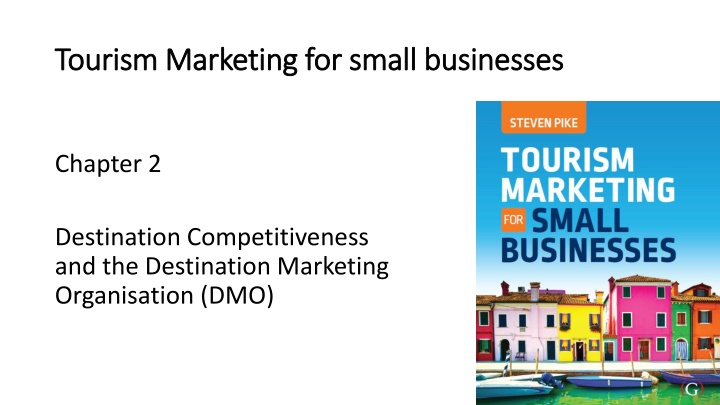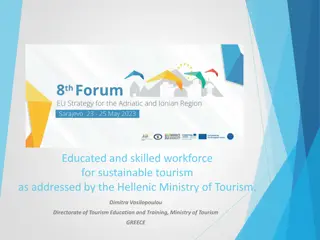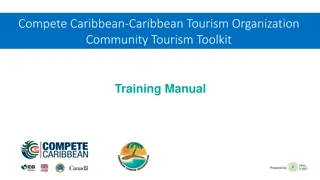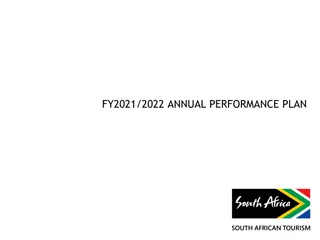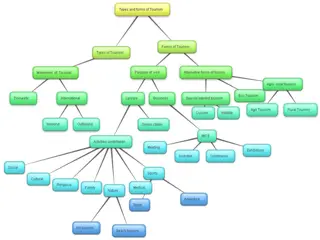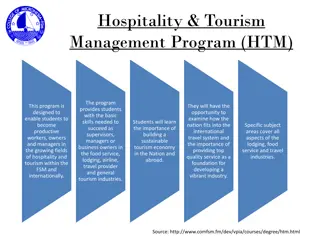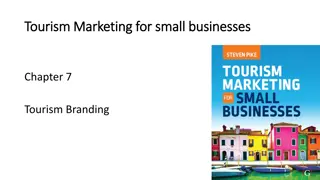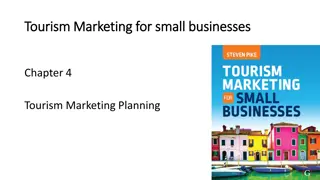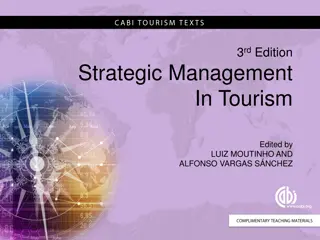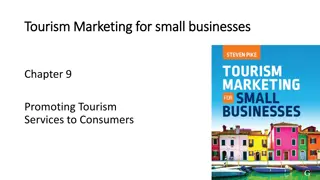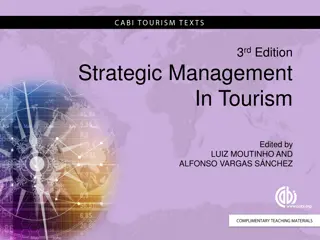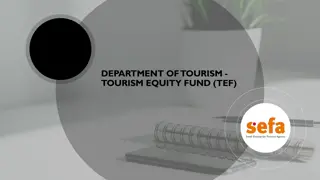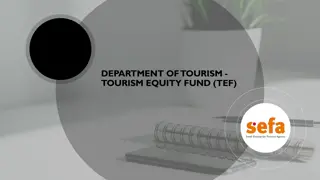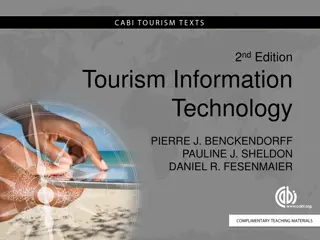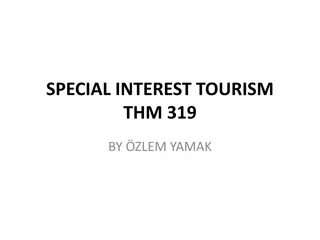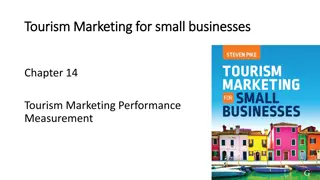Tourism Marketing for small businesses
In Chapter 2 of "Tourism Marketing for Small Businesses," explore the significance of Destination Marketing Organizations (DMOs) in enhancing destination competitiveness. Learn about the key role DMOs play in supporting small tourism businesses, the challenges they face, and the importance of promoting the destination first. Understand the concept of destination competitiveness and the impact of DMOs on economic and social benefits within a community.
Download Presentation

Please find below an Image/Link to download the presentation.
The content on the website is provided AS IS for your information and personal use only. It may not be sold, licensed, or shared on other websites without obtaining consent from the author.If you encounter any issues during the download, it is possible that the publisher has removed the file from their server.
You are allowed to download the files provided on this website for personal or commercial use, subject to the condition that they are used lawfully. All files are the property of their respective owners.
The content on the website is provided AS IS for your information and personal use only. It may not be sold, licensed, or shared on other websites without obtaining consent from the author.
E N D
Presentation Transcript
Tourism Marketing for small businesses Tourism Marketing for small businesses Chapter 2 Destination Competitiveness and the Destination Marketing Organisation (DMO)
Chapter learning aims Chapter learning aims To enhance your understanding of: the role of the DMO in enhancing destination competitiveness opportunities for small tourism businesses to work with the DMO key challenges faced by DMOs
Key terms Key terms Destination competitiveness A competitive destination features an effective market position, an attractive environment, satisfactory visitor experiences, profitable tourism businesses, and supportive local residents. Destination image Images held by travellers of a destination are as important as the tangible attractions and services. Whether the travellers perceptions are correct or not, they do influence travel planning decision making and therefore impact on the competitiveness of the destination. Destination marketing organisation (DMO) A destination marketing organisation (DMO) coordinates the impartial and collaborative promotion of a geo-political boundary, in a holistic manner that enhances economic and social benefits for the wider community.
Proposition underpinning this chapter Proposition underpinning this chapter The success of a tourism business is reliant to a large extent on the competitiveness of the destination Therefore importance of understanding DMOs for tourism managers Hence the destination marketing mantra: Promote the destination first, and your business second
What is a What is a destination destination? ? An island A village Beach City Province (eg Outback Qld), state Country, continent, macro region (eg Caribbean) Usually based on political boundaries due to government funding of the DMO Of little relevance to the traveller?
Consumers spoilt by choice Consumers spoilt by choice Almost unlimited number of destinations to choose from Eg in the USA alone there are over 20,000 cities The worlds top 10 most visited countries account for almost half of all international arrivals The other 95% of countries compete for the other 50% of travellers Including Australia, New Zealand, Canada, South America, most of Europe (eg Greek islands) etc
Destination competitiveness Destination competitiveness A competitive destination is one that features a balance between: profitable tourism businesses an effective market position an attractive environment positive visitor experiences supportive local residents Do these happen by chance?
Destination competitiveness impacted by: Destination competitiveness impacted by: Destination life-cycle Disasters and crises Government travel advisories Emergence of new types of competition Power of travel trade intermediaries Destination image Case 2.1 The rise and fall and resurgence of Rotorua s destination image How can a decline in destination image impact on local tourism businesses?
Destination marketing organisations (DMO) Destination marketing organisations (DMO) A DMO is the result of a community recognising the need to become organised in the pursuit of destination competitiveness The role of the DMO is to impartially coordinate the promotion of the destination, in a holistic manner that enhances economic and social benefits fore the wider community The only element of the marketing mix a DMO has control over is promotion
Cooperating to compete Cooperating to compete Travellers are spoilt by an almost unlimited number of destinations offering similar features and benefits So the majority of places are substitutable in consumers minds Even the most successful destinations cannot take future potential visitation for granted A key focus of DMO activity is stimulating cooperative promotions with local businesses, to stretch the budget and create a bigger impact in the market
DMOs DMOs Trend towards public-private partnerships (PPPs) Government as funder and provider of infrastructure Industry expertise for decision making at board level Anyone with a vested interest in the tourism industry should: understand the arguments for/against public funding of DMOs
Video link Video link Working with VisitEngland https://www.youtube.com/watch?v=WDAVGdBEd_Y
DMO history DMO history Lack of literature relating to the history of DMOs 1864 first Regional Tourism Organisation (RTO) (Switzerland) 1888 first Convention and Visitors Bureau (CVB) (USA) 1901 first National Tourism Office (NTO) (New Zealand) 1903 first State Tourism Office (STO) (Hawaii) 1948 First Macro Marketing Organisation (MMO) (European Travel Commission) Most NTOs formed after World War II Most RTOs formed in the 1980s and 1990s
DMO challenges DMO challenges Over-reliance on government funding Destination branding complexity Politics of DMO decision making Measuring DMO performance Eg of all the visitors in your city today how many as a result of RTO marketing?
Activity 2.1 Activity 2.1 What s the destination slogan What s the destination slogan Without using Google, draw an arrow between each of these destinations and the corresponding brand slogan you think has recently been used by that destination. Las Vegas New Zealand New York Scotland Australia California 100% pure There s nowhere like .. I .. What happens here, stays here Dream big A spirit of its own After checking your responses, discuss why you recognised the brand slogan(s) and not the others.
Activity 2.2 Activity 2.2 Funding decision Funding decision What is your response?
To recap To recap The success of individual tourism businesses is reliant on their destination s competitiveness Tourism businesses need to understand how DMOs operate, to take advantage of cooperative promotional opportunities and navigate the politics
Opportunities for small businesses to work Opportunities for small businesses to work with the DMO with the DMO See Table 2.1 Industry briefings Newsletter Product database Digital library Visiting media program Social media program Educating travel agents Travel trade events and exhibitions Contra prizes Cooperative advertising Destination branding collateral URL link
Video link Video link Working with VisitEngland https://www.youtube.com/watch?v=WDAVGdBEd_Y See Blackboard for Working with Tourism Australia booklet
Discussion questions Discussion questions What is meant by the mantra: promote the destination first, and your business second? Why is it important for local tourism businesses to understand key challenges faced by their DMO? Why are DMOs so reliant on government funding?
